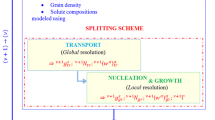Abstract
Segregation and microporosity formation are two important physicalphenomena that occur during solidification of binary alloys. The aim ofthis study is to investigate the effect of the model of solute diffusionat the local scale (which means at the local scale of the microscopicrepresentative elemental average volume (REV)) on solute transport andthe microporosity formation during this process. The Scheil rule and thelever rule are used to describe the solute diffusion at the local scale.Results indicate that solute diffusion at the local scale is animportant factor in microporosity formation. Also, microporosityformation slightly reduces inverse segregation because it partiallycompensates for shrinkage. The increase of the external pressure at thefree surface or the decrease of the initial hydrogen concentration inthe molten alloy can be effectively utilized to control microporosityformation.
Similar content being viewed by others
References
Asai, S. and Muchi, I., Theoretical analysis and model experiments on the formation mechanism of channel-type segregation. Trans. Iron Steel Inst. Japan 18 (1978) 90–98.
Beckermann, C. and Viskanta, R., Double-diffusive convection during dendritic solidification of a binary mixture. PhysicoChem. Hydrodynam. 10 (1988) 195–213.
Bennon, W.D. and Incropera, F.P., A continuum model for momentum, heat and species transport in binary solid-liquid phase changes systems — I. Model formulation. Internat. J. Heat Mass Transfer 30 (1987) 2161–2170.
Bennon, W.D. and Incropera, F.P., A continuum model for momentum, heat and species transport in binary solid-liquid phase changes systems — II. Application to solidification in a rectangular cavity. Internat. J. Heat Mass Transfer 30 (1987) 2171–2187.
Bianchi, M.V.A. and Viskanta, R., Gas segregation during solidification processes. Internat. J. Heat Mass Transfer 40 (1997) 2035–2043.
Devies, V. de L., Feeding range determined by numerically computed heat distribution. AFS Cast Metals Res. J. 11 (1975) 33–44.
Emadi, D., Gruzleski, J.E. and Toguri, J.M., The effect of Na and Sr modification on surface tension and volumetric shrinkage of A356 alloy and their influence on porosity formation. Metallurgical Trans. 24B (1993) 1055–1063.
Ganesan, S. and Poirier, D.R., Conservation of mass and momentum for the flow of interdentritic liquid during solidification. Metallurgical Trans. 21B (1990) 173–181.
Huang, J., Mori, T. and Conley, J.G., Simulation of microporosity in modified and unmodified A356 alloy castings. Metallurgical Trans. 29B (1998) 1249–1260.
Huang, H., Suri, V.K., Hill, J.L. and Berry, J.T., Issues in thermal contact and phase changes in porosity prediction. J. Engrg. Materials Technol. 115 (1993) 2–7.
Iida, T. and Guthrie, R.I.L., The Physical Properties of Liquid Metals. Clarendon Press, Oxford (1988).
Kuznetsov, A.V., Investigation of the coupled heat transfer, fluid flow and the solute transport during the strip casting process. Internat. J. Heat Mass Transfer 40 (1997) 2949–2961.
Kuznetsov, A.V. and Vafai, K., Development and investigation of three-phase model of the mushy zone for analysis of porosity formation in solidifying castings. Internat. J. Heat Mass Transfer 38 (1995) 2557–2567.
Kuznetsov, A.V. and Vafai, K., Comparison between the two-and three-phase models for analysis of porosity formation in aluminum-rich castings. Numer. Heat Transfer, Part A 29 (1996) 859–867.
Lazaridis, A.A., A numerical solution of the multi-dimensional solidification (or melting) problem. Internat. J. Heat Mass Transfer 13 (1970) 1459–1477.
Lee, S.L. and Tzong, R.Y., Latent heat method for solidification process of a binary alloy system. Internat. J. Heat Mass Transfer 38 (1995) 1237–1247.
Mills, A.F., Heat Transfer, 2nd edn. Prentice Hall, Englewood Cliffs, NJ (1999).
Ni, J. and Beckermann, C., A volume averaged two-phase model for transport phenomena during solidification. Metallurgical Trans. 22B (1991) 349–361.
Opie, W.R. and Grant, N.J., Hydrogen solubility in Aluminum and some Aluminum alloys. Trans. AIME, J. Metals 188 (1950) 1237–1241.
Rappaz, M. and Voller, V., Modeling of micro-macrosegregation in solidification processes. Metallurgical Trans. 21A (1990) 749–753.
Piwonka, T.S. and Flemings, M.C., Pore formation in solidification. AMS-AIME Trans. 236 (1966) 1157–1165.
Poirier, D.R., Nandapurkar, P.J. and Ganesan, S., The energy and solute conservation equations for dendritic solidification. Metallurgical Trans. 22B (1991) 889–900.
Poirier, D.R., Yeum, K. and Maples, A.L., A thermodynamic prediction for microporosity formation in aluminum-rich Al-Cu alloys. Metallurgical Trans. 18A (1987) 1979–1988.
Swaminathan, C.R. and Voller, V.R., Towards a general numerical scheme for solidification system. Internat. J. Heat Mass Transfer 40 (1997) 2859–2868.
Viswanathan, S., Sikka, V.K. and Brody, H.D., Using solidification parameters to predict porosity distributions in alloy casting. JOM, J. Minerals Metal & Materials Soc. 44 (1992) 37–40.
Voller, V.R., A similarity solution for the solidification of a multicomponent alloy. Internat. J. Heat Mass Transfer 40 (1997) 2869–2877.
Voller, V.R., A numerical scheme for solidification of an alloy. Canadian Metallurgical Quart. 37 (1998) 169–177.
Voller, V.R., Brent, A.D. and Prakash, C., The modeling of heat, mass and solute transport in solidification systems. Internat. J. Heat Mass Transfer 32 (1989) 1719–1731.
Voller, V.R. and Sundarraj, S., A model of inverse segregation: The role of microporosity. Internat. J. Heat Mass Transfer 38 (1995) 1009–1018.
Xiong, M. and Kuznetsov, A.V., Numerical modeling of microporosity formation in aluminum-rich aluminum-copper alloys in microgravity conditions. In: Kim, J.H. (ed.), Proceedings of ASME Heat Transfer Division 2000, ASME International Mechanical Engineering Congress and Exposition, Orlando, FL, November 5–10. ASME, New York (2000) HTD-Vol. 366–1, pp. 167–177.
Author information
Authors and Affiliations
Rights and permissions
About this article
Cite this article
Xiong, M., Kuznetsov, A. Comparison between Lever and Scheil Rules for Modeling of Microporosity Formation during Solidification. Flow, Turbulence and Combustion 67, 305–323 (2001). https://doi.org/10.1023/A:1015291706970
Issue Date:
DOI: https://doi.org/10.1023/A:1015291706970




